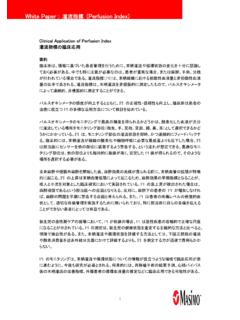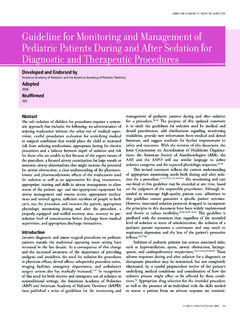Transcription of Perfusion Index Clinical Applications of Perfusion Index
1 Masimo corporation 40 parker irvine ca 92618 IndexSummaryTo make informed patient management decisions, physicians often need to be aware of changes in peripheral Perfusion and circulatory status. This is especially true in patients who are in critical condition, or who are anesthetized, undergoing surgery, or in labor. The Perfusion Index (PI) is the ratio of the pulsatile blood flow to the nonpulsatile or static blood in peripheral tissue. Perfusion Index thus represents a noninvasive measure of peripheral Perfusion that can be continuously and noninvasively obtained from a pulse oximeter. As the sensitivity of certain pulse oximeters has improved, the fidelity and reliability of PI has improved to a level where clinicians are beginning to explore various ways they can utilize PI to care for their patientsOptimal pulse oximetry monitoring accuracy is dependent on the selection of a monitoring site (fingertip, hand, toe, foot, forehead, ear) characterized by good Perfusion with oxygenated blood.
2 The PI provides instant and continuous feedback as to the Perfusion status of the selected monitoring site. In Clinical scenarios where peripheral Perfusion may drop below the minimums required for tissue oxygenation and cellular respiration, the PI alerts the clinician to consider another monitoring site. Optimal monitoring sites are chosen with a relatively high, stable PI. Clinical studies in adult and pediatric patients have demonstrated that an increase in PI is an early indicator that general and epidural anesthesia has initiated peripheral vasodilatation which typically occurs before the onset of the anesthetic effect. Detection of a spike in PI is a sign to the physician of the successful onset of anesthesia.
3 Conversely, no increase in PI in a patient given anesthesia may be an early warning of anesthetic failure. As an objective indicant of pain levels in patients, the PI has been used to determine proper management of pain, especially in patients unable to communicate their discomfort to the clinician. In the neonatal acute care setting, a low PI has been shown to be an objective and accurate measure of acute illness. The determination of PI is unambiguous and independent compared to subjective means of assessing health status in neonates. Additionally, PI measurement represents a more rapid and inexpensive method to assess peripheral Perfusion and circulatory status in comparison to evaluating calf muscle Perfusion and oxygen consumption by way of near-infrared monitoring warrants further exploration for other Clinical Applications where information on peripheral Perfusion or circulatory status would be useful.
4 Potential future Applications include prediction of the success of reimplanted body parts, restoration of peripheral Perfusion after cardiopulmonary bypass, and estimation of volume status in trauma patients. Clinical Applications of Perfusion Index1 masimo corporation 40 parker irvine ca 92618 IndexClinical Interpretation of the Perfusion IndexPerfusion Index is an assessment of the pulsatile strength at a specific monitoring site ( the hand, finger or foot), and as such PI is an indirect and noninvasive measure of peripheral Perfusion . It is calculated by means of pulse oximetry by expressing the pulsatile signal (during arterial inflow) as a percentage of the nonpulsatile signal, both of which are derived from the amount of infrared (940 nm) light PI value is relative to a particular monitoring site, ( the fingertip or toe), of each patient as physiological conditions vary between monitoring sites and individual patients.
5 Masimo Signal Extraction Technology (SET ) pulse oximetry yields continual and simultaneous absolute values and trends with associated alarms for PI, arterial oxygen saturation (SaO2), and pulse rate using validated signal extraction technology. Because SET technology utilizes five signal processing algorithms to deliver high precision sensitivity and specificity in the measurement of blood oxygen saturation levels, the PI parameter can be derived from the core measurements of SET and yields clinically useful information regarding the peripheral Perfusion status of the patient. Other indices of Perfusion derived through infrared absorption data lack the sensitivity technology of SET, which may limit the power of the Index .
6 The ability to trend the PI is critical; only the trend reveals the often subtle changes in Perfusion that are otherwise missed by static displays. These subtle changes captured by the trend provide immediate Clinical feedback of the efficacy of anesthesia, analgesia, and/or therapeutic intervention. Integrating user-formatable alarms with PI provides clinicians with immediate feedback to increases or decreases of PI to gain optimal results in the Clinical management of the in PI can also occur as a result of local vasoconstriction (decrease in PI) or vasodilatation (increase in PI) in the skin at the monitoring site. These changes occur with changes in the volume of oxygenated bloodflow in the skin The measurement of PI is independent of other physiological variables such as heart rate variability, SaO2, oxygen consumption, or temperature.
7 The interpretation of PI depends on the Clinical context to which it is applied. The PI generally changes in proportion to peripheral Perfusion . In certain instances, however, such as in a patient attached to a heart-lung machine, Perfusion can be good but the pulsatile part of the signal is nearly zero because of the absence of a pulse. Even in such an instance, the monitoring of PI in conjunction with examining the photoplethysmogram (pleth) waveform, can give the clinician an indication of the accuracy of the saturation a Monitoring Site in AdultsThe PI is useful for quickly evaluating the appropriateness of a monitoring site for pulse oximetry. A site with a high pulse amplitude (high PI number) generally indicates an optimal monitoring site for other pulse oximetry and Pulse CO-Oximetry measures.
8 The fingertip is the standard monitoring site for pulse oximetry. The hand or foot (sometimes toe) is often used in neonatal patients. Surgical patients, however, are subject to unpredictable changes in peripheral Perfusion , particularly with a large degree of variability in body temperature. Such changes in peripheral Perfusion may have variable effects at different sensor locations. It is useful, therefore, to have an alternative to the standard fingertip sensor site. Monitoring Perfusion Index in Anesthetized PatientsMost anesthetics produce a vasodilatative effect by way of increasing the vasodilatation threshold and decreasing the vasoconstriction Anesthesia can also cause temperature redistribution, which further effects peripheral Perfusion .
9 Perfusion Index has been considered a useful tool for accurately monitoring changes in peripheral Perfusion in real time caused by certain anesthetics. Masimo SET pulse oximetry was used to monitor PI in a study of seven patients undergoing major abdominal In this study, the PI showed a statistically significant correlation with end-expiratory sevoflurane (R= , p< ). In contrast, the more conventional forearm-finger tip gradient did not correlate with either sevoflurane concentration (R = , p = ) or PI (R = , p = ). These results suggest the future value of considering perioperative changes in PI during surgical procedures to monitor temperature redistribution, vasodilatation, and the efficacy of the Anesthesia Working?
10 One valuable consideration during surgery is whether the anesthetized patient demonstrates any signs of a response to painful stimuli. If the patient cannot effectively report pain, as may occur in the anesthetized state, it becomes a challenge for the attending physician to evaluate the effectiveness of the anesthesia being used. A study sought to explore the effect of pain stimuli in healthy subjects anesthetized with sevoflurane by monitoring PI with Masimo SET pulse oximetry and heart rate as objective outcome While anesthesia produces a vasodilatative effect, pain is known to induce vasoconstriction, and it was unknown whether a painful stimulus would still maintain vasoconstriction under the vasodilated condition in normothermic, anesthetized subjects.








